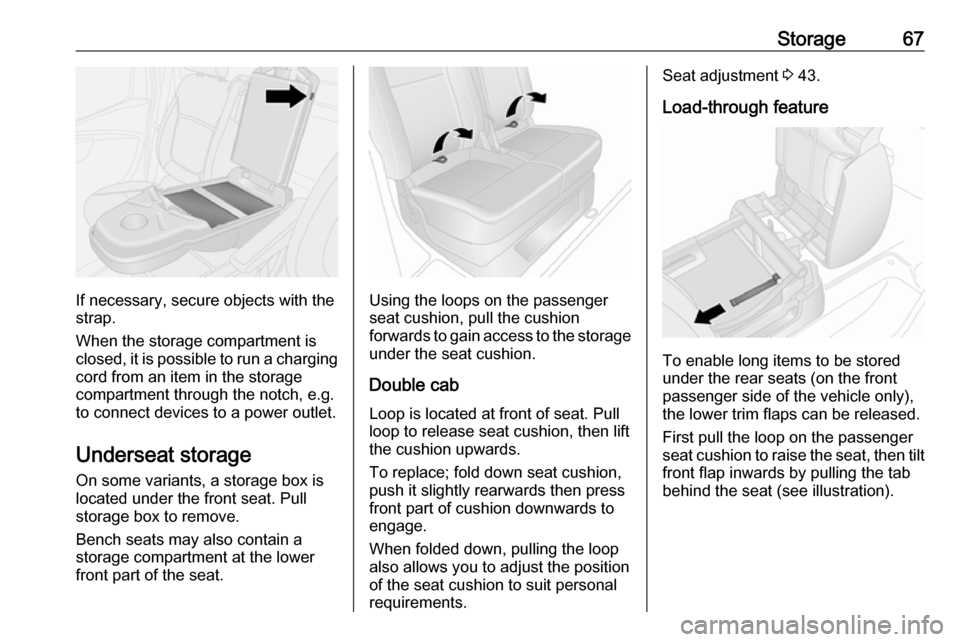VAUXHALL VIVARO 2016 Repair Manual
Manufacturer: VAUXHALL, Model Year: 2016, Model line: VIVARO, Model: VAUXHALL VIVARO 2016Pages: 209, PDF Size: 4.86 MB
Page 61 of 209

Seats, restraints59Child restraint installation locations
Permissible options for fitting a child restraint system Front seats - Van
Weight and age class
Single front passenger seat 1Double front passenger seat
activated airbag
deactivated
or without airbag
activated airbag
deactivated
or without airbagcentreouterGroup 0: up to 10 kg
or approx. 10 months
Group 0+: up to 13 kg
or approx. 2 years
XUXXU
Group I: 9 to 18 kg
or approx. 8 months to 4 yearsXUXXUGroup II: 15 to 25 kg
or approx. 3 to 7 years
Group III: 22 to 36 kg
or approx. 6 to 12 years
XUXXU
1:Forward-facing child restraints: Remove head restraint 3 41. Slide seat as far back as possible. Set seat height to
highest position. Maximum backrest rake is 25°. Seat adjustment 3 43.
Page 62 of 209

60Seats, restraintsFront seats - Combi, Double cab
Weight and age class
Single front passenger seat1Double front passenger seat
activated airbag
deactivated
or without airbag
activated airbag
deactivated
or without airbagcentreouterGroup 0: up to 10 kg
or approx. 10 months
Group 0+: up to 13 kg
or approx. 2 years
XUXXU
Group I: 9 to 18 kg
or approx. 8 months to 4 yearsXU 2XXU 2Group II: 15 to 25 kg
or approx. 3 to 7 years
Group III: 22 to 36 kg
or approx. 6 to 12 years
XXXXX
1:If adjustable, slide seat as far back as possible and set seat height to highest position. Maximum backrest rake is
25°. Seat adjustment 3 43.2:Rear-facing child restraints only for this weight and age class.
Page 63 of 209

Seats, restraints61Rear seats - Combi, Double cabWeight and age class2nd row seats13rd row seatsGroup 0: up to 10 kg
or approx. 10 months
Group 0+: up to 13 kg
or approx. 2 years
UU
Group I: 9 to 18 kg
or approx. 8 months to 4 yearsU 2U2Group II: 15 to 25 kg
or approx. 3 to 7 years
Group III: 22 to 36 kg
or approx. 6 to 12 years
U 2U 2
1:If necessary, slide adjustable front seat forwards to install a child restraint system on these seats. There may not be
enough clearance to install particular child restraint systems on vehicles fitted with fixed front seats.2:Forward-facing child restraints: Remove head restraint 3 41 before installing child restraint. The seat in front of this
installation position must not be more than halfway back on its runners. Maximum backrest rake is 25°. Seat adjustment
3 43.U:Suitable for universal category restraint systems for use in this weight and age class, in conjunction with three-point
seat belt.X:Seat position not suitable for children in this weight and age class.
Page 64 of 209

62Seats, restraintsPermissible options for fitting an ISOFIX child restraint systemWeight classSize
classFixtureFront seats2nd row seats 13rd row
seatsCentreOutervehicles with single
passenger seatvehicles with
double passenger
seatGroup 0: up to 10 kg
or approx. 10 monthsEISO/R1XXILILXGroup 0+: up to 13 kg
or approx. 2 yearsEISO/R1XXILILXDISO/R2XXILXXCISO/R3XXILXXGroup I: 9 to 18 kg
or approx. 8 months to 4 yearsDISO/R2XXILXXCISO/R3XXILXXBISO/F2XXIL, IUF 2IL, IUF2XB1ISO/F2XXXIL, IUF 2IL, IUF2XAISO/F3XXIL, IUF2IL, IUF2XGroup II: 15 to 25 kg
or approx. 3 to 7 yearsXXIL, IUF2IL, IUF2XGroup III: 22 to 36 kg
or approx. 6 to 12 yearsXXIL, IUF2IL, IUF2X
Page 65 of 209

Seats, restraints631:If necessary, slide adjustable front seat forwards to install a child restraint system on these seats. There may not beenough clearance to install a child restraint system on vehicles fitted with fixed front seats.2:Forward-facing child restraints: Remove head restraint 3 41 before installing child restraint. The seat in front of this
installation position must not be more than halfway back on its runners. Maximum backrest rake is 25°. Seat adjustment
3 43.IUF:Suitable for ISOFIX forward-facing child restraint systems of universal category approved for use in this weight class.X:No ISOFIX child restraint system approved in this weight class.IL:Suitable for particular ISOFIX restraint systems of the 'specific-vehicle', 'restricted' or 'semi-universal' categories.
The ISOFIX restraint system must be approved for the specific vehicle type.
ISOFIX size class and seat device
A - ISO/F3:Forward-facing child restraint system for children of maximum size in the weight class 9 to 18 kg.B - ISO/F2:Forward-facing child restraint system for smaller children in the weight class 9 to 18 kg.B1 - ISO/F2X:Forward-facing child restraint system for smaller children in the weight class 9 to 18 kg.C - ISO/R3:Rear-facing child restraint system for children of maximum size in the weight class up to 18 kg.D - ISO/R2:Rear-facing child restraint system for smaller children in the weight class up to 18 kg.E - ISO/R1:Rear-facing child restraint system for young children in the weight class up to 13 kg.
Page 66 of 209

64Seats, restraintsIsofix child restraint systemsISOFIX mounting brackets are
indicated by the ISOFIX logo or
symbol on the seat cushion.
Fasten vehicle-approved ISOFIX
child restraint systems to the ISOFIX
mounting brackets.
When using ISOFIX mounting
brackets for seat mounting,
universally approved child restraint
systems for ISOFIX may be used.
Permissible mounting location
positions for ISOFIX child restraint
systems are marked in the tables by
< , IL and IUF.
Top-tether fastening eyes
Top-Tether fastening eyes are
located on the back of the seat.
In addition to the ISOFIX mounting,
fasten the Top-Tether strap to the
Top-Tether fastening eyes. The strap
must run between the two guide rods
of the head restraint.
ISOFIX child restraint systems of
universal category positions are
marked in the table by IUF.
Page 67 of 209

Storage65StorageStorage compartments................65
Instrument panel storage ...........65
Glovebox ................................... 65
Cupholders ................................ 66
Front storage ............................. 66
Underseat storage .....................67
Overcab storage ........................68
Load compartment .......................68
Load compartment cover ...........68
Lashing eyes ............................. 69
Safety net .................................. 69
Warning triangle ........................70
First aid kit ................................. 70
Roof rack system .........................71
Roof rack ................................... 71
Loading information .....................71Storage compartments9Warning
Do not store heavy or sharp
objects in the storage
compartments. Otherwise, the
storage compartment lid could
open and vehicle occupants could be injured by objects being thrown
around in the event of hard
braking, a sudden change in
direction or an accident.
Instrument panel storage
Storage compartments, pockets and
trays are located in the instrument
panel.
A coin holder, a phone holder, and a
tablet holder may be located on the
instrument panel.
The tray located on top of the
instrument panel has a lid.
Glovebox
To open, pull the handle.
Depending on version, the glovebox
may feature a light that comes on
when the glovebox is opened, and
may also be lockable.
The glovebox should be closed while
driving.
Page 68 of 209

66StorageCupholders
Cupholders are located at both ends
of the instrument panel, centrally in the lower instrument panel and in the
rear seat area.
Additional cupholders are located on
the back of the folded down centre
rear seat 3 66, 3 45.
The cupholders can also be used to hold the portable ashtray unit 3 78.
Remove the portable ashtray unit to
use the cupholders.
Front storage
Coat hooks are located on the cabin
bulkhead and on the grab handles in
the roof lining.
The front door pockets contain bottle
holders.
Folding centre seatback
The centre seat backrest, when
folded fully forwards, features a
storage compartment, cupholder and
a document tray.
Press button (arrowed) on rear side of
backrest to unlock the document tray
and access the storage
compartments.
To install the document tray, insert
the end piece(s) into any of the slots
by the cupholder.
The document tray must always be
returned to its original position before
raising the seat backrest.
Page 69 of 209

Storage67
If necessary, secure objects with the
strap.
When the storage compartment is
closed, it is possible to run a charging cord from an item in the storage
compartment through the notch, e.g.
to connect devices to a power outlet.
Underseat storage
On some variants, a storage box is located under the front seat. Pull
storage box to remove.
Bench seats may also contain a
storage compartment at the lower
front part of the seat.Using the loops on the passenger
seat cushion, pull the cushion
forwards to gain access to the storage
under the seat cushion.
Double cab
Loop is located at front of seat. Pull
loop to release seat cushion, then lift
the cushion upwards.
To replace; fold down seat cushion,
push it slightly rearwards then press
front part of cushion downwards to
engage.
When folded down, pulling the loop also allows you to adjust the positionof the seat cushion to suit personal
requirements.
Seat adjustment 3 43.
Load-through feature
To enable long items to be stored
under the rear seats (on the front
passenger side of the vehicle only),
the lower trim flaps can be released.
First pull the loop on the passenger
seat cushion to raise the seat, then tilt front flap inwards by pulling the tab
behind the seat (see illustration).
Page 70 of 209

68Storage
Fold up the rear flap by hand; it is
retained in the open position by
magnets.
9 Warning
Passengers must not use the seat
when transporting objects
beneath it with the lower trim flaps
opened.
Overcab storage
The total weight in this compartment
must not exceed 35 kg.
Load compartment
Load compartment cover
Rear parcel shelf Do not place any excessively heavy
or sharp-edged objects on the rear
parcel shelf.
The maximum load permissible is
50 kg.9 Warning
Always make sure that the load in
the vehicle is securely stowed.
Otherwise objects can be thrown
around inside the vehicle and
cause personal injury or damage
to the load or car.